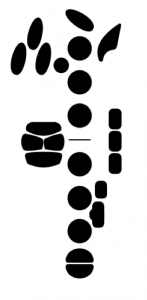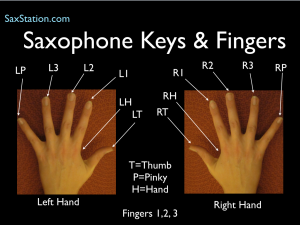 How can my ten fingers handle all the keys on the sax?
How can my ten fingers handle all the keys on the sax?
(Playing for one week)
-Fori
My response:
On the diagram on the right, we see 23 keys.
Your saxophone might be a tiny bit different, not having a high F# key, having a low A key, or potentially having a few other differences if it’s really old. But basically a saxophone has 23 keys.
Some of your fingers are only responsible for pressing one key. Other fingers are responsible for multiple keys.
You use 9 of your fingers to press keys on the saxophone. Your right thumb, underneath the thumb rest is exempt.
Here is a diagram with your fingers labeled, as well as the side of the hands as ‘LH’ and ‘RH’
Left Hand
Your left thumb is in charge of pressing one key, the octave key.
The first finger on your left hand (L1) can press three different keys- B, bis key, high F key
With the option of pressing two at once (B key and bis key).
The second finger on your left hand (middle finger, L2) presses only one key, the one to play ‘C’.
The third finger on your left hand (L3) presses only one key.
Your left pinky can press any of the four table keys.
The side of your left hand (LH) can press the three palm keys. One, two or three at a time depending on the note you want to play.
Right Hand
Your right thumb goes under the thumb rest, it presses no keys.
The first finger on your right hand (R1) presses one key.
The second finger on your right hand (middle finger, R2) presses only one key.
The third finger on your right hand (R3) presses one key normally and can press two others, the alternative F# and the high F#.
Your right pinky can press the two bottom keys for D#/Eb and low C.
The side of your right hand (RH) can press the three keys. The most common one being side Bb, another for an alternative C and a third for higher notes.




I am comfortable on the saxophone except the high F# and E
Keep working on them, sometimes things that are new are uncomfortable. Using the palm keys is something you only need for a few notes, and it feels different.
I have been playing the sax for four years now. It’s natural for me to play all the notes that are required in a piece of music. For my first time though, I had trouble playing certain notes and such.
My band director gave us a music book. In the back of the book, was a fingering chart that I studied and played constantly to keep my mind up to date which notes were which and now I’ve got it pretty much down.
I suggest taking things one note at a time and get a fingering chart and different music pieces and go along with both and you will get used to using all of your fingers on the sax 🙂
Thanks for the input Megan.
Certain fingerings I find really hard – even after practising. for example – low C# (getting my little finger on the left hand in position), high E and Eb. Especially with high E and Eb my right hand seems to fly out. The worst is if I am going to the high E/Eb to say Bb using the side key or vice versa. any ideas to help me get these?
When you say low C#, you’re talking about coming from what note to the low C#?
With high Eb, there isn’t really a reason for your right hand to fly off since you’re not using it for that note. Being aware is good, try to correct that. With high E, my right hand does get a little out of position, but not too much.
Try slowing down and moving less.